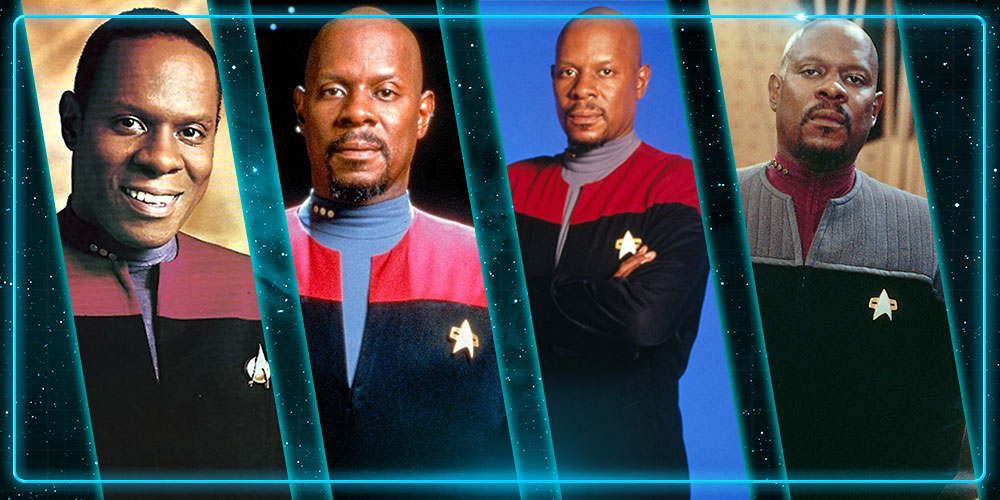Commander, then Captain, Benjamin Sisko: 1995 – 2000
Picard’s trauma did not take place in a vacuum. Many other people were affected adversely by his actions whilst under the control of the Borg Collective.
Most notably was the next character I am considering, Commander Benjamin Sisko, whose wife was killed in the Borg attack led by Picard as Borg.
Inextricably linked, then, to the character of Jean-Luc Picard is Commander Benjamin Sisko of the 1995 series Star Trek: Deep Space Nine.
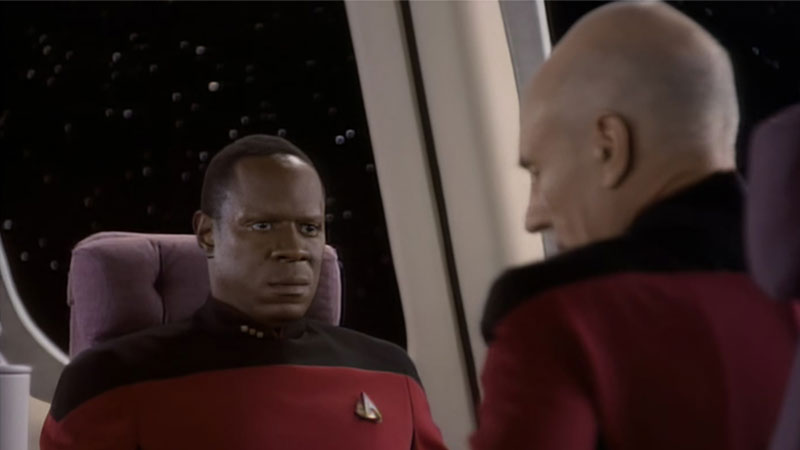
The Emissary
Commander Sisko made history by being the first Black lead character on a Star Trek show.
Deep Space Nine made history by being the first Star Trek to transition from episodic storytelling to serialized plot and character arcs. This change of structure permitted the show to explore more deeply than any previous Star Trek themes of trauma, PTSD, and grief.
Benjamin Sisko was a lead character, unlike his predecessors. Marianne Kac-Verne provided essential cultural context. Although she discusses two films unrelated to Trek, she recognizes a shift in science fiction media away from the ’80s and 90’s hegemonic masculinity toward the “New Man” of the later ’90s.
She explains that “changing definitions of masculinity in US public discourse at the time, which turned away from rugged, aggressive and determined fighters to celebrate sensitive ‘New Men’” (13). She goes on to describe these ‘New Men’ as involved and nurturing fathers who are aware of their feelings and egalitarian toward women (13).
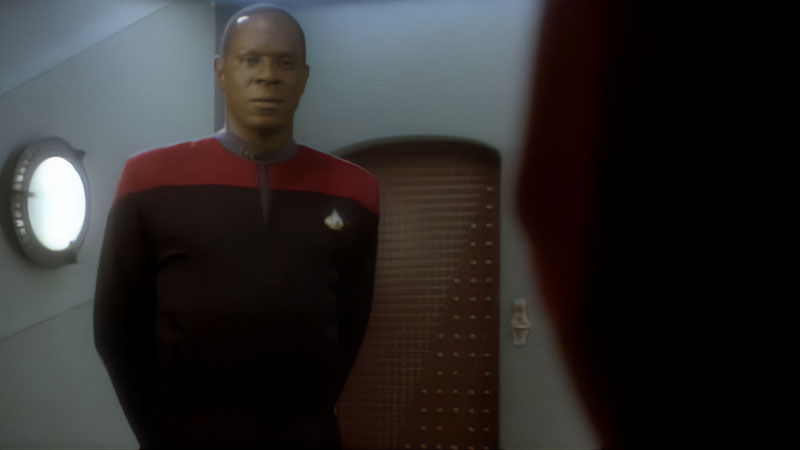
Sisko: A New Man
Sisko is an exemplary example of the New Man of the 90s. In contrast to Kirk, whom we never saw openly weeping, and who was awkward around children, and Picard, who only openly wept under extreme duress, and who was also awkward around children, Sisko openly weeps in his very first television appearance.
While Kirk is portrayed as completely unaffected by his own trauma and losses and Picard is portrayed as completely debilitated by his own, Sisko is a much more layered and nuanced portrayal of trauma.
Sisko is an excellent example of post-traumatic growth. To better understand that phenomenon, I turned to the studies of psychologists Lawrence G. Calhoun and Richard G. Tedeschi.
They explain that while the concept of post-traumatic growth (PTG), “the idea that an individual’s encounter and struggle with life trauma can lead to significant growth” (4) is in fact an ancient concept, the systematic focus by scholars and researchers is in fact quite recent.
They wrote the very first book on the topic, and in their follow-up work, an anthology entitled “Handbook of Posttraumatic Growth,” they join with other researchers to provide a roadmap for that PTG journey. This book helps to identify that Sisko’s spiritual epiphany following his placement in his role as a spiritual leader could be the most salient argument of all for PTG:
It is in the realm of existential and, for some persons, spiritual and religious matters that the most significant PTG may be experienced. …
The experiences that comprise this domain tend to reflect a greater sense of purpose and meaning in life, greater satisfaction, and perhaps clarity with the answers given to existential questions. For some persons, the experience can include deeply meaningful spiritual elements (6).
Commander Benjamin Sisko’s very first television appearance in the pilot episode “Emissary” is a moving depiction of his journey to come to terms with his wife’s death.
Through contact with non-corporeal beings, he has a chance to go back to the moments of their shared lives together and relive them. He comes back again and again to the moment when he kneels beside her dead body and knows she is gone.
The non-corporeal beings ask him, “Why do you exist here?” It is through their intervention that Sisko realizes that he has never left that moment in time and moved forward, and in that realization, he is finally freed to begin to grieve. He kneels and weeps.
Sisko’s spiritual experiences made him more at peace with himself and those around him and served to give him closure to one of the most traumatic incidents of his life.
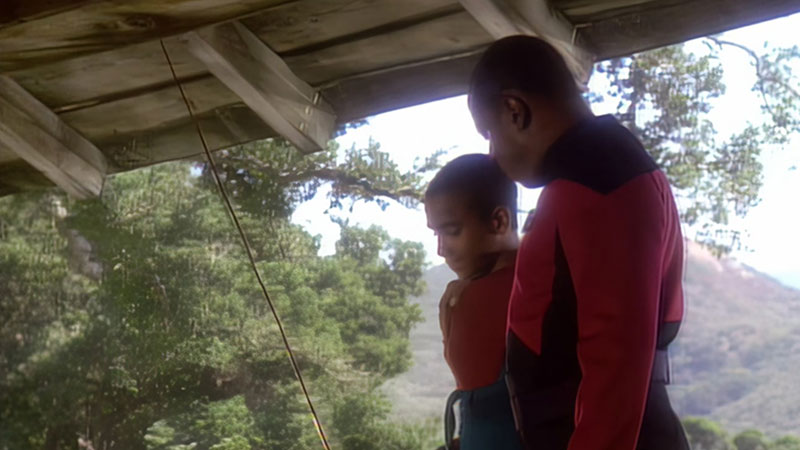
Sisko the Role Model
Beginning with “Emissary” and continuing throughout the series, Sisko becomes a much-needed role model.
A strong, professional, highly respected Black man, leader, soldier, devoted single father and faithful friend, he models a Black man who can openly and unashamedly grieve. In her book “We Real Cool: Black Men and Masculinity,” bell hooks eloquently argue the desperate need for the Black community to have a role model for dealing with pain and trauma.
She explains, “In traditional patriarchal black culture, male grieving has no place. The black man who grieves is seen as weak. Oftentimes the only black male we see expressing grief (other than at a funeral) is the drunk whose emotionality is dismissed as caused merely by his addiction and not by pain” (93).
Sisko was a much-needed role model because of the very scarcity of those Black male role models in ’90s media. Kac-Verne provides essential cultural context: “In 1980s science fiction, power, toughness, and integrity are most often reserved to white male heroes.
Minority members are secondary characters who can sometimes help the hero but usually disappear during the action, leaving the white hero to fight on his own” (6). She goes on to explain that Black and minority characters were often killed brutally in 80’s science fiction films, or used as comic relief, or to demonstrate hypersexuality.
They were seldom written as heroes in their own stories. Therefore, the depiction of Sisko’s Black masculinity was so important for science fiction.
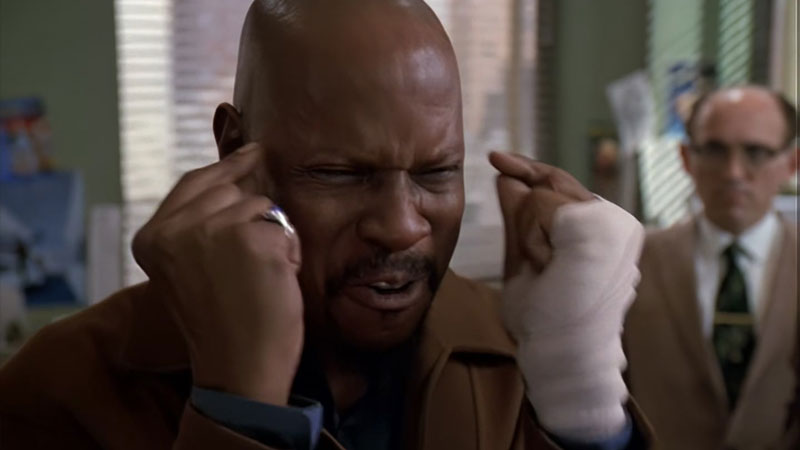
Far Beyond the Stars
It would be immoral for the writers of a ground-breaking series like Deep Space Nine to avoid addressing Black male pain.
The episode “Far Beyond the Stars” eloquently portrays Black male pain in a way that resonates today. Through another encounter with the non-corporeal beings, Sisko is transported back in time to 1950s Detroit.
There, in the guise of Benny Russel, he confronts the racism facing Black male science fiction writers of the time. In what is one of the most powerful episodes on television, Sisko gives voice to Black male pain. “You can’t kill the dream!” he shouts.
And, denied creative expression because he is a Black man, but refusing to give up on the hope for a better life for his community, he weeps before succumbing to a mental breakdown.
Baseball, Cooking, and Sailboats
Yet Sisko is so much more than just a role model and voice for Black male pain; he is a richly layered complex character who loves baseball, Creole cooking, and building solar sailboats.
He spends every available moment nurturing his son Jake, listening to Jake’s struggles, encouraging him to find his own path, and displaying open affection and tenderness. He gathers a team of fellow officers around him and makes them his closest friends.
He moves from being an embittered widower who does not want to be at his assigned posting to a man who loves his work and has found profound meaning in it. He becomes both a political and a spiritual leader upon the planet he is assigned to protect. He becomes a highly decorated soldier and a captain with a ship of his own.
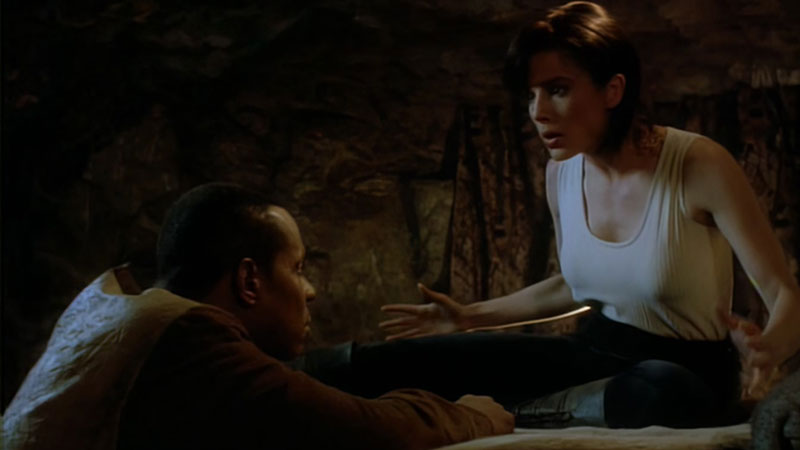
Unspoken Trauma
But there is one trauma in Sisko’s life that did not get resolved. I would like to return to a concern I highlighted in the Kirk section, and that is, what effect do non-consensual, dubious consensual, or even coerced consent, sexual relations have upon masculinity?
For all its progress in accurately portraying PTSD in Deep Space Nine episodes such as “Hard Time” “It’s Only A Paper Moon” and “The Seige of AR-558,” Star Trek is consistently reluctant to engage in the discussion of sexual trauma in men.
In the episode “Through The Looking Glass,” set in the so-called “mirror universe,” Sisko confronts a “dark mirror” image of one of his oldest, dearest friends, Jadzia Dax. In “his” timeline, there is the deepest mutual respect and admiration between the two platonic friends, but in the “mirror universe,” the evil version of the two characters are lovers.
In order to maintain his cover and protect his crew, “good” Sisko is forced into a situation in which he has no choice but to engage in sexual relations with “evil” Jadzia. There is no follow-up, no discussion about male consent or agency, and no acknowledgement that being forced into a sexual situation to which he cannot consent is damaging to men.
Science fiction has a very long and ugly history of blurring the clear lines between consensual and non-consensual relations. Worse, as Laura Hudson reminds us in her essay
“Star Trek: Discovery’s Latest Episode Makes A Rare Point About Male Rape Survivors,”
“the sexual assault of men is often played as a joke in media, where the punchline is that the man probably wanted it, or at least didn’t mind that much. Even Star Trek itself hasn’t always been immune to this pernicious myth.”
It is my hope that continuing the conversation around this topic will encourage change.
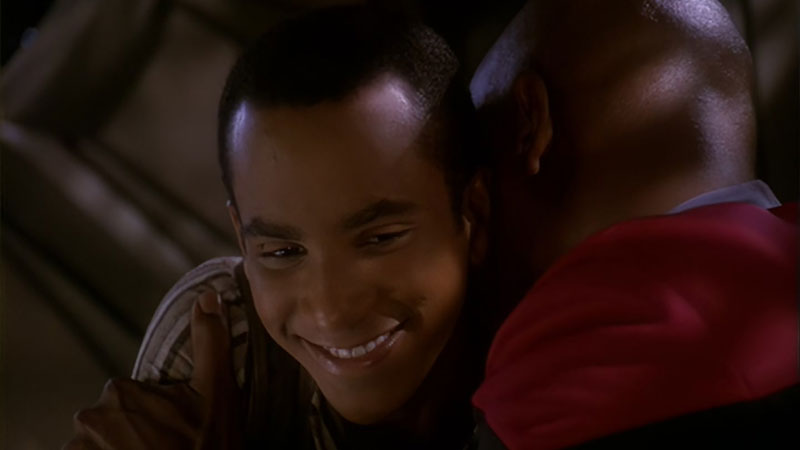
Nor the Battle to the Strong
Sisko passes on down his distilled wisdom from his experiences with trauma throughout the series, most notably in conversation with his son Jake in “Nor The Battle To The Strong.”
After thoughtfully reading an article Jake wrote about his experiences in a war zone, Sisko told his son, “Most of us who have been in battle would recognize himself in this. And most of us wouldn’t care to admit it.
It takes courage to look inside yourself and even more courage to write it for other people to see. I’m proud of you, son.”
Author’s note: the following is the third of three sections from a research paper I wrote for my English Masculinities college course this spring. I’m very proud of my paper and wanted to share it with everyone.
References & Sources Cited
- Calhoun, Lawrence G. and Tedeschi, Richard G. Handbook of Post-Traumatic Growth: Research and Practice. Routledge. 2006
- Clark, Janine Natalya. The Vulnerability of the Penis: Sexual Violence against Men in Conflict and Security Frames. Men and Masculinities, vol. 22, no. 5, 2017, pp. 778–800.
- Decker, Jonathan. “Therapist Reacts to Star Trek: First Contact. YouTube. Uploaded to Cinema Therapy. October 12, 2021. https://youtu.be/m9gUjcisy5Q
- Earl, Jessie. Star Trek Portrayals of Trauma and PTSD. YouTube. Uploaded to Jessie Gender. https://youtu.be/Cs1XsOiiXqk
- Hudson, Laura. “Star Trek: Discovery’s latest episode makes a rare point about male rape survivors: The other conversation about sexual assault we need to have.” The Verge. November 13, 2017. https://www.theverge.com/2017/11/13/16644468/star-trek-discovery-rape
- Herman, Judith Lewis. Trauma and Recovery: The Aftermath of Violence, from Domestic Abuse to Political Terror. Basic Books, a Member of the Perseus Books Group. 2015.
- hooks, bell. We Real Cool: Black Men and Masculinity. Routledge. 2004.
- Kac-Vergne, Marianne. “Losing Visibility? The Rise and Fall of Hypermasculinity in Science Fiction Films.” InMedia, no. 2. 2012.
- Kimmel, Michael S. Manhood in America: A Cultural History. Oxford University Press. 2006.
- Neilson, E. C., Singh, R. S., Harper, K. L., & Teng, E. J. (2020, January 27). Traditional Masculinity Ideology, Posttraumatic Stress Disorder (PTSD) Symptom Severity, and Treatment in Service Members and Veterans: A Systematic Review. Psychology of Men & Masculinities. Advance online publication. http://dx.doi.org/10.1037/men0000257
- Sychterz, Jeffrey. Mad Masculinity: Alcohol, War and Constructing Masculinity in Mad Men. 2013.

